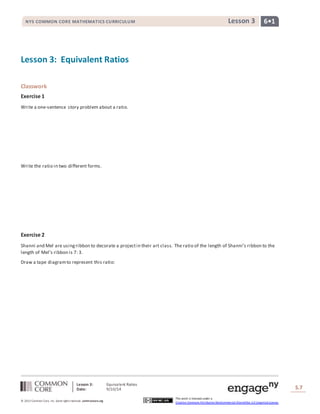More Related Content
Similar to G6 m1-a-lesson 3-s
Similar to G6 m1-a-lesson 3-s (20)
G6 m1-a-lesson 3-s
- 1. NYS COMMON CORE MATHEMATICS CURRICULUM Lesson 3 6• 1
Lesson 3: Equivalent Ratios
Date: 9/10/14
S.7
© 2013 Common Core, Inc. Some rights reserved. commoncore.org
This work is licensed under a
Creative Commons Attribution-NonCommercial-ShareAlike 3.0 Unported License.
Lesson 3: Equivalent Ratios
Classwork
Exercise 1
Write a one-sentence story problem about a ratio.
Write the ratio in two different forms.
Exercise 2
Shanni and Mel are using ribbon to decorate a project in their art class. The ratio of the length of Shanni’s ribbon to the
length of Mel’s ribbon is 7: 3.
Draw a tape diagram to represent this ratio:
- 2. NYS COMMON CORE MATHEMATICS CURRICULUM Lesson 3 6• 1
Lesson 3: Equivalent Ratios
Date: 9/10/14
S.8
© 2013 Common Core, Inc. Some rights reserved. commoncore.org
This work is licensed under a
Creative Commons Attribution-NonCommercial-ShareAlike 3.0 Unported License.
Exercise 3
Mason and Laney ran laps to train for the long-distance running team. The ratio of the number of laps Mason ran to the
number of laps Laney ran was 2 to 3.
a. If Mason ran 4 miles, how far did Laney run? Draw a tape diagram to demonstrate how you found the answer.
b. If Laney ran 930 meters, how far did Mason run? Draw a tape diagram to determine how you found the
answer.
c. What ratios can we say are equivalent to 2:3?
- 3. NYS COMMON CORE MATHEMATICS CURRICULUM Lesson 3 6• 1
Lesson 3: Equivalent Ratios
Date: 9/10/14
S.9
© 2013 Common Core, Inc. Some rights reserved. commoncore.org
This work is licensed under a
Creative Commons Attribution-NonCommercial-ShareAlike 3.0 Unported License.
Exercise 4
Josie took a long multiple-choice, end-of-year vocabulary test. The ratio of the number of problems Josie got incorrect
to the number of problems she got correct is 2:9.
a. If Josie missed 8 questions, how many did she get right? Draw a tape diagram to demonstrate how you found
the answer.
b. If Josie missed 20 questions, how many did she get right? Draw a tape diagram to demonstrate how you found
the answer.
c. What ratios can we say are equivalent to 2:9?
- 4. NYS COMMON CORE MATHEMATICS CURRICULUM Lesson 3 6• 1
d. Come up with another possible ratio of the number Josie got wrong to the number she got right.
Lesson 3: Equivalent Ratios
Date: 9/10/14
S.10
© 2013 Common Core, Inc. Some rights reserved. commoncore.org
This work is licensed under a
Creative Commons Attribution-NonCommercial-ShareAlike 3.0 Unported License.
e. How did you find the numbers?
f. Describe how to create equivalent ratios.
- 5. NYS COMMON CORE MATHEMATICS CURRICULUM Lesson 3 6• 1
Two ratios 퐴: 퐵 and 퐶: 퐷 are equivalent ratios if there is a positive number, 푐, such that 퐶 = 푐퐴 and 퐷 = 푐퐵.
Ratios are equivalent if there is a positive number that can be multiplied by both quantities in one ratio to equal
the corresponding quantities in the second ratio.
Lesson 3: Equivalent Ratios
Date: 9/10/14
S.11
Lesson Summary
© 2013 Common Core, Inc. Some rights reserved. commoncore.org
This work is licensed under a
Creative Commons Attribution-NonCommercial-ShareAlike 3.0 Unported License.
Problem Set
1. Write two ratios that are equivalent to 1:1.
2. Write two ratios that are equivalent to 3:11.
3.
a. The ratio of the width of the rectangle to the height of the rectangle is ________ to _________.
b. If each square in the grid has a side length of 8 mm, what is the length and width of the rectangle?
4. For a project in their health class, Jasmine and Brenda recorded the amount of milk they drank every day. Jasmine
drank 2 pints of milk each day, and Brenda drank 3 pints of milk each day.
a. Write a ratio of number of pints of milk Jasmine drank to number of pints of milk Brenda drank each day.
b. Represent this scenario with tape diagrams.
c. If one pint of milk is equivalent to 2 cups of milk, how many cups of milk did Jasmine and Brenda each drink?
How do you know?
d. Write a ratio of number of cups of milk Jasmine drank to number of cups of milk Brenda drank.
e. Are the two ratios you determined equivalent? Explain why or why not.
